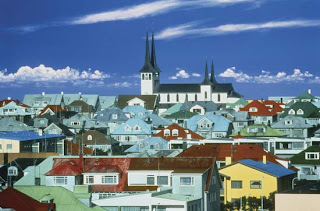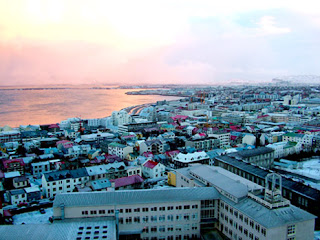Reykjavík is located in southwest Iceland. The Reykjavík area coastline is characterized by peninsulas, coves, straits, and islands. During the Ice Age (up to 10,000 years ago) a large glacier covered parts of the city area, reaching as far out as Álftanes. Other parts of the city area were covered by sea water. In the warm periods and at the end of the Ice Age, some hills like Öskjuhlíð were islands. The former sea level is indicated by sediments (with clams) reaching (at Öskjuhlíð, for example) as far as 43 m (141.08 ft) above the current sea level. The hills of Öskjuhlíð and Skólavörðuholt appear to be the remains of former shield volcanoes which were active during the warm periods of the Ice Age. After the Ice Age, the land rose as the heavy load of the glaciers fell away, and began to look as it does today. But the capital city area continued to be shaped by earthquakes and volcanic eruptions, like the one 4500 years ago in the mountain range Bláfjöll, when the lava coming down the Elliðaá valley reached the sea at the bay of Elliðavogur. The largest river to run through Reykjavík is the Elliðaá River, which is non-navigable. It is one of the best salmon fishing rivers in the country. Mt. Esja, at 914 m (2,998.69 ft), is the highest mountain in the vicinity of Reykjavík.
The city of Reykjavík is mostly located on the Seltjarnarnes peninsula, but the suburbs reach far out to the south and east. Reykjavík is a spread-out city; most of its urban area is in the form of low-density suburbs, and houses are usually widely spaced. The outer residential neighborhoods are also widely spaced from each other; in between them run the main traffic arteries and a lot of empty space.






No comments:
Post a Comment